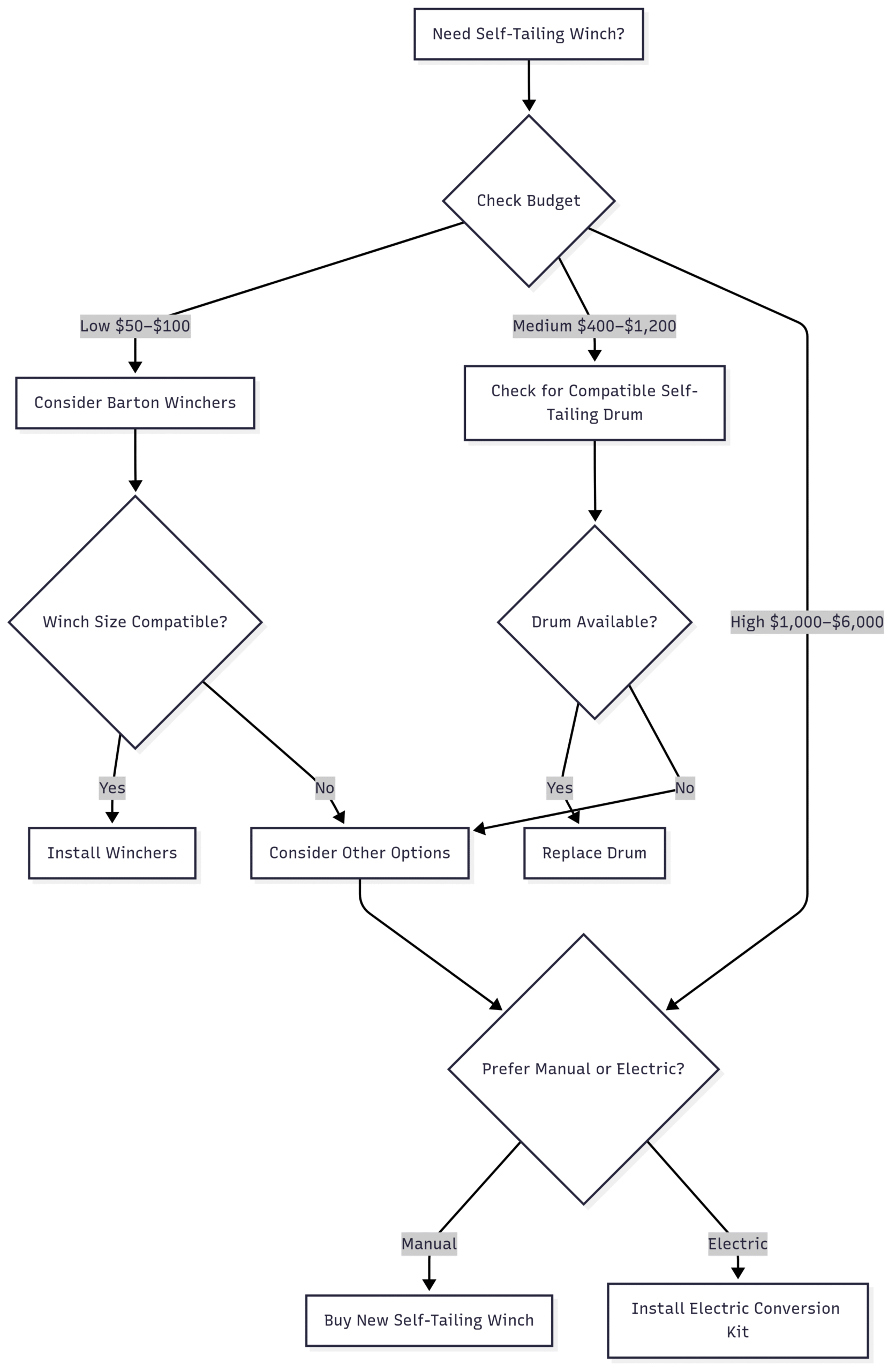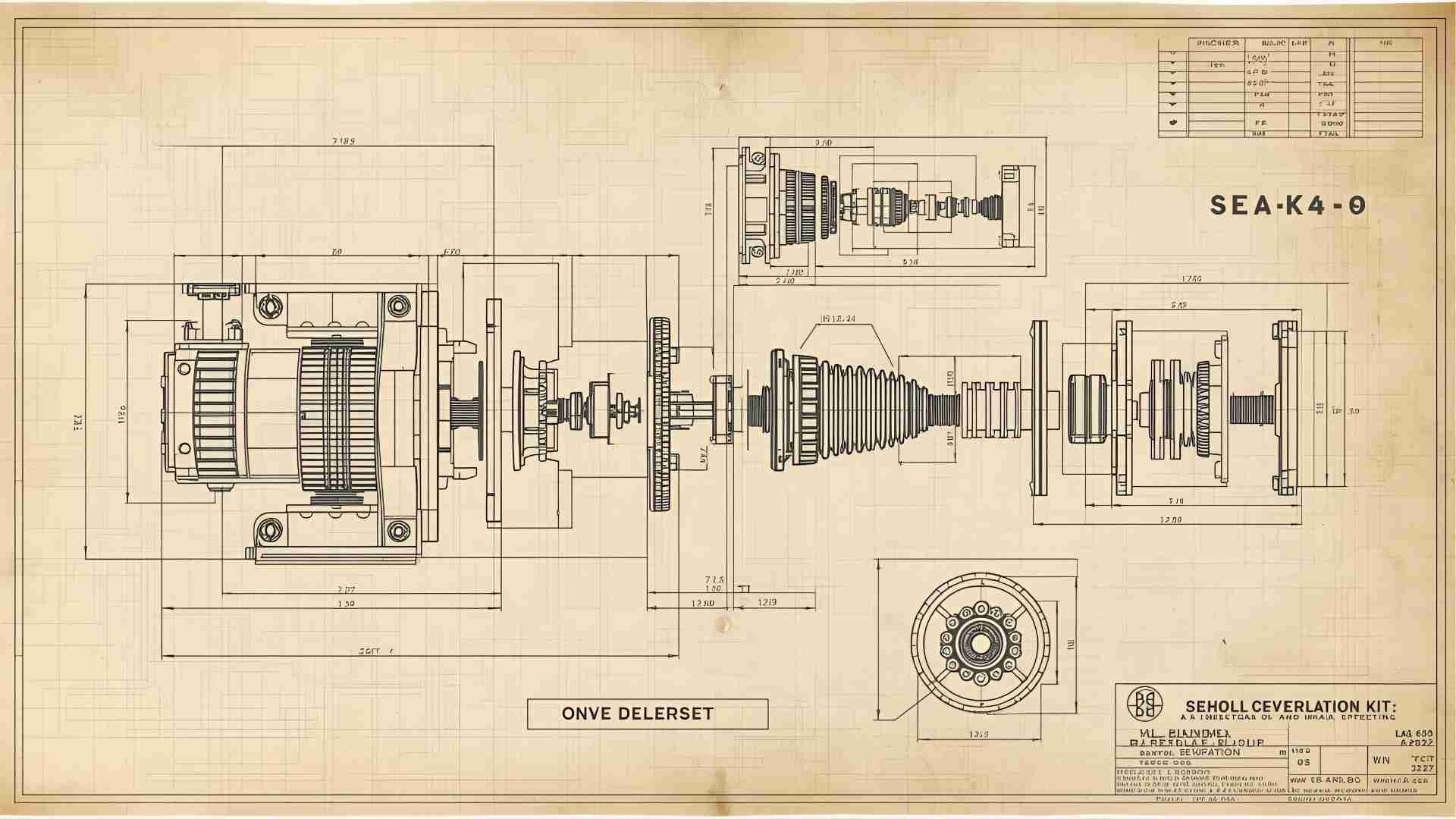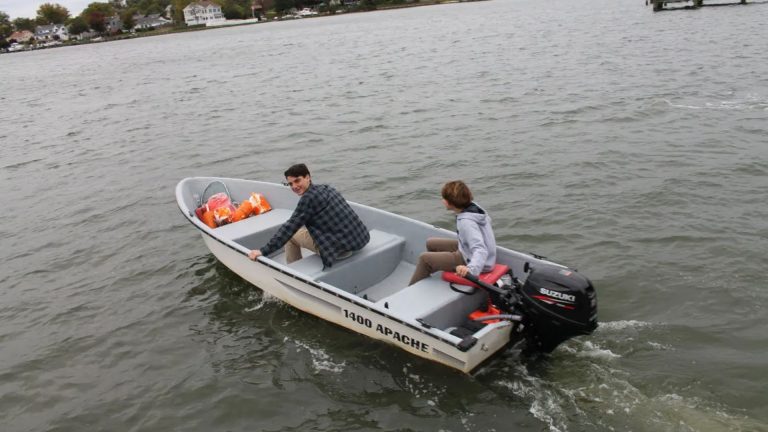Is there a conversion kit for upgrading a winch to self-tailing?
Discover how to upgrade your winch to self-tailing with conversion kits, drum replacements, or new winches. Learn methods, pros, cons, and costs.
Sailing demands precision and efficiency, especially when managing lines under load. For solo sailors or those handling larger vessels, self-tailing winches are a game-changer. These devices automatically grip the rope, eliminating the need for manual tailing and freeing up hands for other tasks. But what if your boat is equipped with standard winches? Can they be upgraded to self-tailing functionality, and if so, how? This comprehensive guide explores the methods to convert a standard winch to self-tailing, including conversion kits, drum replacements, full winch replacements, and electrification. We’ll dive into the pros, cons, costs, and practical considerations, ensuring you have the information needed to make an informed decision.
What Is a Self-Tailing Winch?
A self-tailing winch is designed to hold and tension a line automatically as it’s wound, allowing sailors to operate it without manually pulling the tail end of the rope. This is achieved through a feeder arm that guides the line into a set of jaws at the top of the winch drum. These jaws grip the rope securely, enabling single-handed operation—a critical advantage for solo sailors or short-handed crews. Unlike standard winches, which require one hand to crank and another to tail, self-tailing winches streamline sail handling, improve safety, and reduce fatigue.
For sailors with older boats or smaller budgets, replacing standard winches with self-tailing models can be cost-prohibitive. Fortunately, several methods exist to upgrade existing winches, ranging from affordable add-ons to complete replacements. Below, we outline the four primary approaches, their benefits, drawbacks, and practical applications.
Methods to Convert a Winch to Self-Tailing
1. Winch Conversion Kits (e.g., Barton Winchers)
Winch conversion kits, such as Barton Marine’s Winchers, offer a budget-friendly solution to add self-tailing functionality to standard winches. These kits consist of a rubber molding that fits over the winch drum, creating a gripping surface for the rope. When the line is under tension, it climbs the drum and is held in place by the rubber’s underside, mimicking the action of a self-tailing winch.
How It Works
The Barton Wincher operates by using the rope’s tension to wedge it between the rubber molding and the drum. The line is wrapped around the drum, and as it’s tensioned, it moves upward into the Wincher’s grip. A ribbed groove on top of the Wincher acts as a cleat, allowing the line to be secured without an external cleat.
Specifications and Sizes
Barton Winchers are available in four sizes to accommodate various winch drum diameters and rope sizes. The table below outlines the specifications:
| Wincher Size | Drum Diameter (mm) | Rope Diameter (mm) | Bottom Opening (mm) | Compatible Winches |
|---|---|---|---|---|
| Small | 64–70 | 8–10 | 74.6 | Lewmar 7, 8, 16; Harken B8, B16.2; Antal W8 |
| Medium | 70–80 | 10–14 | 78.5 | Lewmar 30, 40; Harken B32.2, B40.2; Antal W9, W16, W30 |
| Large | 80–90 | 12–14 | 100 | Lewmar 44; Antal W42 |
| X-Large | 90–100 | 12–16 | 101.6 | Antal W44, W47, W48; Harken B42.2 |
Pricing
Barton Winchers are sold in pairs, with prices typically ranging from $50 to $100 per pair, depending on size and retailer (e.g., West Marine, Amazon). This makes them significantly cheaper than new self-tailing winches, which can cost $500–$2,300 each.
Pros
- Cost-Effective: At $50–$100 per pair, Winchers are a fraction of the cost of new winches.
- Easy Installation: Requires minimal tools (screwdrivers) and can be installed in 20–30 minutes.
- Durability: Users report Winchers lasting 5–20 years, even in harsh marine environments.
- Universal Fit: Compatible with most standard winches from brands like Lewmar, Harken, and Antal.
Cons
- Not True Self-Tailing: Winchers act as line captivators rather than full self-tailing mechanisms. They hold the line but don’t feed it automatically like true self-tailing winches.
- Requires Full Drum: The drum must be fully wrapped with rope for the Wincher to grip effectively, which can be limiting for smaller winches.
- Slower Release: Removing the line during tacking can be slower compared to true self-tailing winches.
- Mixed Reviews: Some sailors find Winchers less reliable under high loads or with improperly sized ropes, with occasional slipping reported.
Installation Process
- Soak the Wincher: Submerge the Wincher in hot, soapy water to soften the rubber.
- Disassemble the Winch: Remove the top disc and screws of the winch drum using a flathead and Phillips screwdriver.
- Fit the Wincher: Stretch the softened Wincher over the drum. This can be tight, but a snug fit ensures better grip.
- Reassemble: Replace the drum and flip the Wincher’s rubber edge over the drum’s top, using a screwdriver to ease it into place.
- Test Fit: Ensure the Wincher is secure and test with the appropriate rope size.
User Feedback
Sailors have mixed opinions on Barton Winchers. Some, like those on a Catalina 27 or O’Day, find them “handy” for small adjustments and single-handing, appreciating their simplicity and low cost. Others, particularly racers or those with larger boats, argue they’re not a substitute for true self-tailing winches, citing issues with slipping under high loads or slower line release during tacking. For example, a sailor on a Macgregor 25 found Winchers incompatible with their small Lewmar 6 winches (drum diameter ~4.5 mm too small), highlighting the importance of checking compatibility.
2. Replacing the Winch Drum
Another approach is to replace the standard winch drum with a self-tailing drum from the same manufacturer. This method is less common but viable for specific winch models where compatible self-tailing drums are available.
How It Works
Manufacturers like Lewmar, Harken, or Barient may offer self-tailing drums for older models (e.g., Lewmar 16, 24, 30). The replacement drum includes the feeder arm and jaws, transforming the winch into a true self-tailing unit.
Pricing
Replacement drums vary widely in cost, typically ranging from $200 to $600 per winch, depending on the model and availability. Sourcing used or discontinued parts through sailing forums, eBay, or Craigslist can reduce costs.
Pros
- True Self-Tailing: Provides full self-tailing functionality with a feeder arm and jaws.
- Cost Savings: Cheaper than replacing the entire winch.
- Retains Existing Base: No need to modify the boat’s deck or mounting.
Cons
- Limited Availability: Compatible drums are hard to find for older or less common winch models (e.g., Gibb Sheetmaster).
- Compatibility Issues: The drum must match the exact winch model, which requires precise measurements and research.
- Installation Complexity: May require technical expertise to ensure proper fit and function.
User Feedback
Sailors on forums like SailNet suggest running “wanted” ads on sailing sites to find used self-tailing drums for older Lewmar or Barient winches. Success stories are rare, as this method depends heavily on finding the right part.
3. Replacing with a New Self-Tailing Winch
The most reliable but expensive option is to replace standard winches with new self-tailing models. Brands like Lewmar, Harken, and Antal offer a range of self-tailing winches designed for various boat sizes and applications.
How It Works
New self-tailing winches come with integrated feeder arms and jaws, providing seamless line handling. They can be single-speed, two-speed, or electric, depending on your needs.
Pricing
Prices for new self-tailing winches vary by size and brand:
- Lewmar 16ST: ~$539 each (West Marine)
- Lewmar 40ST: ~$800–$1,200 each
- Harken B40.2ST: ~$1,000–$1,500 each
- Lewmar 58ST: ~$2,300 each
West Marine’s annual Buy One Get One (BOGO) promotion can halve the cost, making two winches available for the price of one (e.g., two Lewmar 16STs for $539).
Pros
- Optimal Performance: True self-tailing functionality with no compromises.
- Reliability: New winches are designed for modern sailing demands.
- Warranty: Typically come with manufacturer warranties (1–5 years).
Cons
- High Cost: $500–$2,300 per winch, plus installation costs.
- Installation Effort: Requires deck modifications if the new winch has a different footprint.
- Overkill for Small Boats: May be unnecessary for boats under 28 feet.
User Feedback
Sailors upgrading to new self-tailing winches, especially during West Marine’s BOGO sales, report significant improvements in ease of use and safety, particularly for single-handing. However, the high cost deters many, especially for smaller boats.
4. Electrifying Existing Winches
For those seeking maximum convenience, electrifying a manual winch (with or without self-tailing conversion) is an option. Brands like Harken and Lewmar offer electric conversion kits for specific models, adding a motor and gearbox to power the winch.
How It Works
An electric conversion kit replaces the manual crank with a motor, allowing push-button operation. Self-tailing functionality can be added simultaneously by using a self-tailing drum or a Winchmate kit.
Pricing
Electric conversion kits cost $1,000–$3,000 per winch, depending on the model and motor size. For example, a Lewmar electric conversion kit for a size 40 winch retails for ~$1,500–$2,000.
Pros
- Ease of Use: Ideal for single-handing or physically demanding conditions.
- Versatility: Can be combined with self-tailing upgrades.
- Efficiency: Reduces physical effort, especially on larger boats.
Cons
- High Cost: Comparable to or more expensive than new self-tailing winches.
- Space Requirements: Requires below-deck space for the motor and gearbox.
- Electrical Upgrades: May necessitate rewiring or battery upgrades.
User Feedback
A sailor on a Hunter 36 reported success with Lewmar’s electric conversion kit during a BOGO sale, describing it as “powerful” and transformative for single-handing. However, the need for sufficient below-deck space and electrical capacity limits its feasibility.
Comparing the Options
To help you choose, the following table summarizes the key factors:
| Method | Cost (per pair) | Ease of Installation | Performance | Best For |
|---|---|---|---|---|
| Barton Winchers | $50–$100 | Easy (20–30 min) | Moderate | Budget-conscious, small boats |
| Drum Replacement | $400–$1,200 | Moderate–Difficult | High | Specific winch models |
| New Self-Tailing Winch | $1,000–$4,600 | Difficult | Excellent | High-budget, larger boats |
| Electric Conversion | $2,000–$6,000 | Complex | Excellent | Single-handing, large boats |
Key Considerations for Upgrading
- Winch Compatibility: Verify that conversion kits or replacement drums match your winch model (e.g., Lewmar 6, Barient 28). Measure drum diameter and check manufacturer specifications.
- Rope Size: Ensure the rope diameter matches the kit or winch specifications (e.g., 8–16 mm for Barton Winchers).
- Installation: Follow manufacturer instructions precisely. For complex upgrades (drum replacement or electrification), professional installation may be required.
- Space Requirements: Electric conversions need below-deck space for motors and wiring.
- Budget: Balance cost against performance needs. Winchers are ideal for casual sailors, while new winches or electric conversions suit serious cruisers or racers.
Chart: Decision-Making Process
To visualize the decision-making process, the following flowchart outlines the steps to choose the best upgrade method:

Recommendations for Solo Sailors
For solo sailors on smaller boats (e.g., Macgregor 25, Catalina 27), Barton Winchers are the most practical and affordable option. They provide sufficient line-holding capability for casual sailing and are easy to install. However, ensure your winch drum diameter falls within the 64–100 mm range, and use the correct rope size (8–16 mm). For example, a Lewmar 6 winch (drum diameter ~60 mm) may be too small for Winchers, as reported by a Macgregor 25 owner.
For larger boats or serious cruisers, consider a Winchmate conversion kit (if available) or new self-tailing winches. Winchmate kits, priced at ~$500 per winch, offer true self-tailing performance and are praised by users on Barient 28s and 30s. New winches, while expensive, provide the best long-term solution, especially if purchased during sales like West Marine’s BOGO.
Electric conversions are ideal for sailors who frequently single-hand larger boats (e.g., Hunter 36) and have the budget and space for installation. They combine self-tailing functionality with powered operation, maximizing ease of use.
Conclusion
Upgrading a standard winch to self-tailing is a practical way to enhance your sailing experience, particularly for solo or short-handed sailors. Barton Winchers offer a low-cost, easy-to-install solution for casual sailors, though they don’t match the performance of true self-tailing winches. Replacing the drum or installing a Winchmate kit provides a more robust upgrade, while new self-tailing winches or electric conversions deliver top-tier performance at a higher cost. By carefully assessing your winch model, rope size, budget, and sailing needs, you can choose the method that best balances cost and functionality. For most small-boat sailors, starting with Barton Winchers is a smart, budget-friendly step toward easier sail handling.
Happy Boating!
Share Is there a conversion kit for upgrading a winch to self-tailing? with your friends and leave a comment below with your thoughts.
Read 3 Creative Boat Prop Cover Ideas for Winter until we meet in the next article.






